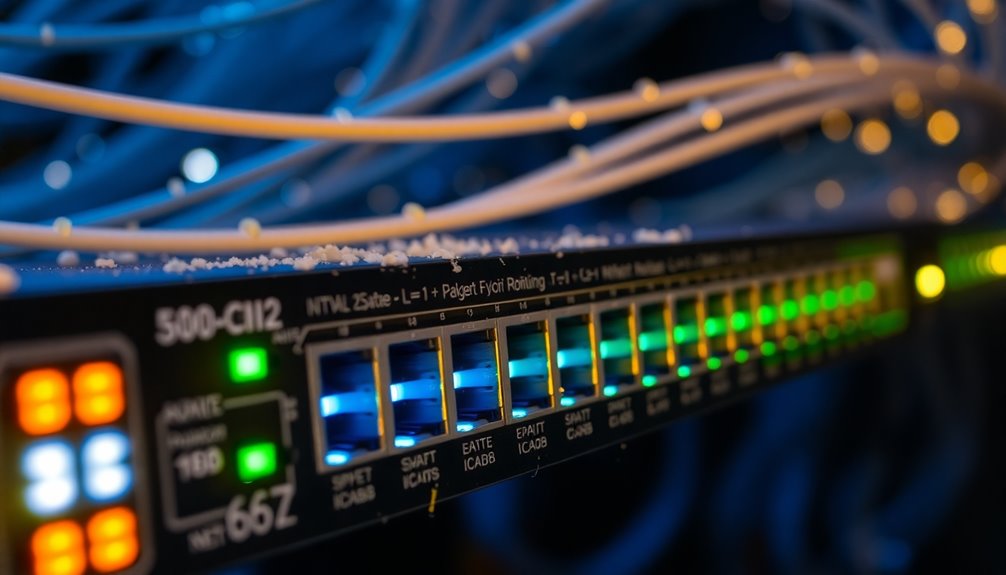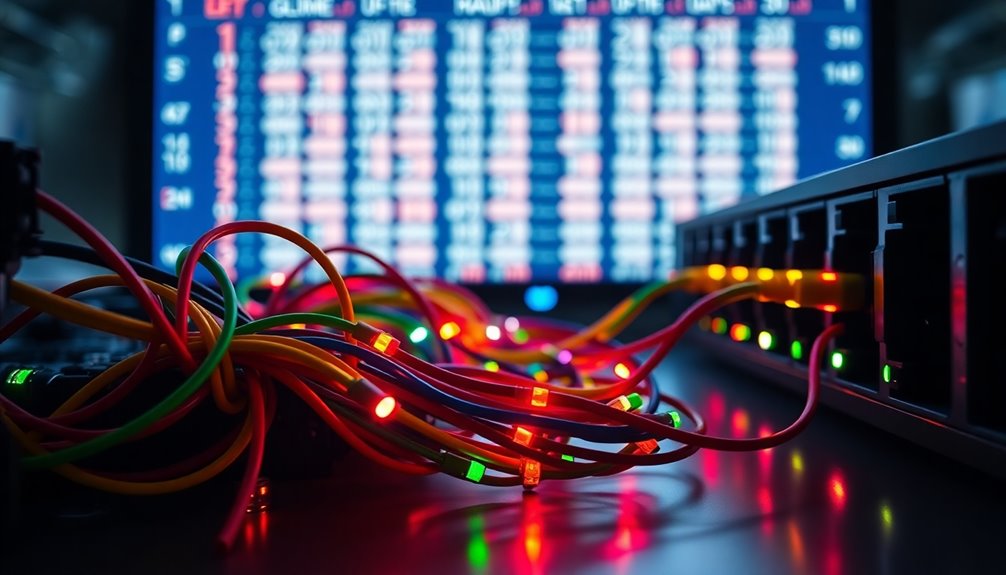Layer 3 is crucial for connecting devices across networks and managing data traffic. It uses IP addresses to logically group devices and facilitate routing between different subnets. This layer allows routers to determine the best paths for data transmission, enhancing network performance and efficiency. Essential protocols like BGP and OSPF help in routing decisions, while Layer 3 switches combine functions of both switches and routers. While it offers high performance and scalability, it can also come with increased costs and complexity. If you're curious about the protocols and techniques that make Layer 3 so effective, there's plenty more to explore.
Key Takeaways
- Layer 3 is the network layer responsible for logical addressing and data forwarding across different subnets using IP addresses.
- It utilizes routing protocols such as OSPF and BGP to determine optimal data paths for efficient communication.
- Layer 3 devices, like routers and Layer 3 switches, manage network traffic and enhance performance through advanced routing techniques.
- The layer improves scalability and security by organizing devices into networks and managing traffic prioritization effectively.
- It contrasts with Layer 2, which operates at the data link layer, forwarding data based on MAC addresses rather than IP addresses.
Layer 3 Networking Fundamentals

Layer 3 networking serves as the backbone of data communication, enabling devices to interact across diverse networks.
At this layer, IP addresses play a crucial role in logical addressing, allowing you to group devices by networks or subnets. Each IP address contains a network part and a local part, much like ZIP codes, ensuring unique identification across various networks. Layer 3 also facilitates data forwarding between devices and manages routing among different subnets. Routers, the primary devices here, connect networks to the internet while switches can perform routing tasks within a local network. Additionally, protocols like BGP and OSPF are essential for effective data routing, ensuring efficient and reliable communication. Logical addressing at Layer 3 provides the foundation for this routing process, allowing for the efficient management of data traffic across networks.
Layer 3 Overview and Significance

The network layer, or Layer 3 of the OSI Model, plays a vital role in modern data communication. It handles essential functions like routing, forwarding, and addressing, ensuring data gets to its intended destination. Devices such as routers and Layer 3 switches operate at this layer, utilizing protocols like IPv4, IPv6, and ICMP. Layer 3 is crucial for establishing network paths, known as virtual circuits, which help manage traffic effectively. By prioritizing data transfer based on message type and destination, it enhances overall network performance. Additionally, it facilitates communication between different networks, allowing seamless data exchange and connectivity. Understanding Layer 3's significance helps you appreciate how data flows across diverse networks. Furthermore, it reduces CPU load by blocking unnecessary broadcast and multicast traffic, which contributes to more efficient network operations.
Packet Routing Mechanisms Explained

Understanding how data travels across networks brings us to packet routing mechanisms, which are fundamental to directing traffic in a Layer 3 environment.
These mechanisms rely on routing protocols like OSPF, BGP, and EIGRP to find the best path for data. Older protocols, although outdated, like IGRP and EGP, laid the groundwork. Additionally, common routing protocols ensure that data can be efficiently routed across various network architectures.
Routing tables play a key role, storing routes and updating them based on calculated paths, ensuring efficient communication.
Routers and Layer 3 switches manage traffic between subnets, enforcing routing policies and improving network performance.
Unique IP addressing and subnetting further enhance organization and security, while supporting both IPv4 and IPv6 to meet diverse needs.
All these components work together to ensure robust and reliable network operation.
Pros and Cons of Layer 3

While deciding on network infrastructure, weighing the pros and cons of Layer 3 switches is crucial.
On the plus side, they offer high performance, efficiently managing traffic with lower latency and enabling inter-VLAN routing without separate routers. Their scalability means they can handle growing networks and large user bases effectively. Advanced security features enhance network manageability, making them ideal for managing data traffic within LANs and between segments.
However, they come with higher costs and increased complexity, requiring skilled personnel for configuration and management. You might also find that they consume more power, impacting operational costs.
Additionally, performance trade-offs can occur, as inspecting all data packets may slow down speeds. Balancing these factors will help you make an informed decision for your network needs.
Layer 3 vs. Layer 2

When comparing Layer 3 and Layer 2 switches, it's essential to recognize their distinct roles within a network.
Layer 3 switches operate at the network layer, using IP addresses to route traffic and connect different VLANs and subnets, which enhances scalability and performance. They're versatile, combining both switching and routing capabilities. Layer 3 switches also facilitate communication between multiple network segments, improving overall network efficiency.
In contrast, Layer 2 switches function at the data link layer, forwarding data based solely on MAC addresses within a single broadcast domain, making them suitable for smaller networks.
While Layer 2 switches are cost-effective with easy setup, Layer 3 switches excel in handling complex, large-scale environments.
Ultimately, your choice depends on the specific needs of your network and its future growth potential.
Security Vulnerabilities in Routing

As networks grow more complex, security vulnerabilities in routing become increasingly concerning. One major issue is the lack of cryptographic authentication in BGP, which allows misleading routes to propagate easily. Misconfigurations can also lead to traffic hijacking or redirection, making networks vulnerable. RPKI implementations often lack resilience and can propagate invalid routes due to operating in fail-open mode. Additionally, routers face threats from hardcoded credentials and remote code execution vulnerabilities, putting your data at risk. To address these challenges, the need for improved tools in RPKI implementations has become essential to enhance overall routing security. Layer 3 DDoS attacks exploit ICMP floods, IP fragmentation, and amplification, overwhelming your network devices. To safeguard your infrastructure, consider implementing rate limiting, traffic filtering, and regular vulnerability testing to bolster your defenses.
Emergence of IPV6 Adoption

The emergence of IPv6 adoption marks a crucial turning point in the evolution of the internet, addressing the limitations of its predecessor, IPv4.
You'll notice that IPv6 adoption is steadily increasing worldwide, with significant growth in Europe, India, and North America. By 2024, about 42-47% of global internet traffic will utilize IPv6, and this is projected to exceed 50% by 2025. The rising number of mobile devices and government initiatives are strong drivers behind this shift. Countries like France and Germany lead in IPv6 traffic, while North America is expected to cross the 50% threshold soon. As the IPv6 market size improves and more users connect, the transition to IPv6 is becoming essential for future internet functionality and growth.
Optimize Routing Table Efficiency

To optimize routing table efficiency, network administrators must employ a combination of dynamic and static routing strategies.
Using dynamic routing protocols like OSPF, RIP, and BGP, your routing tables can automatically populate with the latest network topology changes. This ensures accuracy and responsiveness to device failures or congestion. dynamic routing protocols enable routers to build routing tables based on path metrics and maintain consistent updates through information exchange.
Meanwhile, static routes provide stability when needed. You can reduce routing table size through techniques like route summarization, which aggregates multiple routes, and route filtering, which helps eliminate unnecessary entries.
Implementing CIDR and effective subnetting will also streamline address management. Additionally, leveraging Layer 3 switches enhances routing decisions, while load balancing through ECMP improves performance.
Together, these strategies create a more efficient and manageable routing environment.
Frequently Asked Questions
How Does Layer 3 Interact With Higher Network Layers?
Layer 3 interacts with higher network layers by ensuring efficient data transmission and communication. It forwards packets based on routing information, which the transport layer relies on for maintaining connections.
You'll find that Layer 3's error reporting helps the transport layer achieve reliable data transfer.
Additionally, it aids the session layer in establishing connections and managing resources, while also supporting the presentation layer in formatting and ensuring the integrity of data.
What Devices Operate at Layer 3?
You'll find several devices operating at Layer 3, including routers, layer 3 switches, and firewalls.
Routers route data packets by inspecting IP addresses and using routing tables for efficient paths.
Layer 3 switches enhance LAN performance by combining switching and routing functions.
Firewalls control traffic through packet inspections and filtering, boosting security.
Each device plays a crucial role in managing data flow and ensuring effective communication across networks.
How Does Layer 3 Impact Internet Speed?
When you think about internet speed, imagine navigating a busy city street versus cruising on a clear highway.
Layer 3 switches act like intelligent traffic controllers, efficiently routing data and minimizing congestion. By examining destination IPs and maintaining routing tables, they speed up data flow.
This ensures quicker access to content, whether you're streaming videos or sharing files, creating a smoother online experience that keeps frustration at bay.
You'll notice the difference instantly.
What Are Common Protocols Used at Layer 3?
You'll often encounter several common protocols at Layer 3, including Internet Protocol (IPv4 and IPv6) for addressing and routing.
Open Shortest Path First (OSPF) and Border Gateway Protocol (BGP) are vital for routing decisions, while Routing Information Protocol (RIP) aids in distance-vector routing.
Don't forget about Address Resolution Protocol (ARP) for resolving IP to MAC addresses, and Internet Control Message Protocol (ICMP) for handling error messages.
Each plays a crucial role in networking.
Can Layer 3 Operate Without Layer 2?
Imagine sending a beautifully wrapped gift, only to realize you forgot the box.
That's Layer 3 without Layer 2. You can't operate effectively because Layer 3 depends on Layer 2 for sending data packets.
It needs Layer 2 to encapsulate packets in frames, allowing them to traverse the physical network.
Without that foundational layer, you can't resolve addresses or ensure your data reaches its destination safely.
Conclusion
In summary, Layer 3 networking is crucial for efficient data transmission across the internet. By understanding its role in packet routing and the differences from Layer 2, you can make informed decisions for your network. While vulnerabilities exist, the rise of IPv6 shows that the future of networking is bright, like a smartphone in a world of flip phones. Embrace these advancements to optimize your routing table and enhance your overall network performance!









